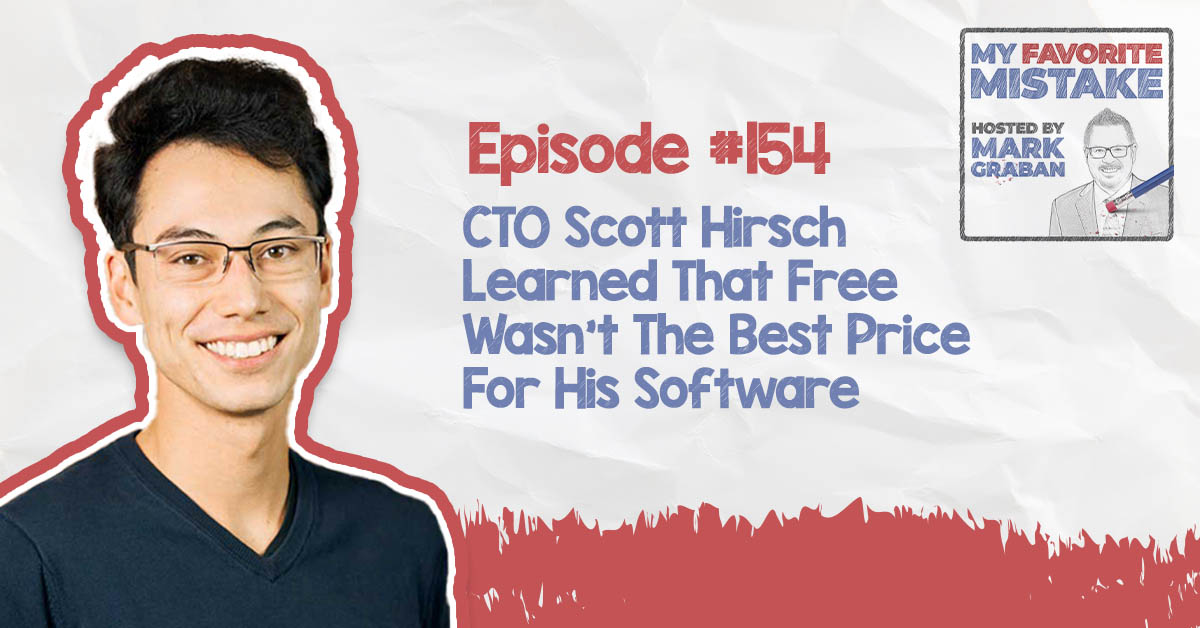Listen:
Check out all episodes on the My Favorite Mistake main page.
My guest for Episode #154 of the My Favorite Mistake podcast is Scott Hirsch, the co-founder and Chief Technology Officer at the HR platform Talent Marketplace. With work experience combining business administration and computer science, Scott's passions lie in enabling business processes through the innovative use of technology.
In today's episode, Scott shares his “favorite mistake” story about setting the beta version of their platform as free. They launched the platform for free and “got almost no response.” Once they put a fee to it, clients started coming in, as Scott tells us. How did they decide their initial pricing was a mistake?
Questions and Topics:
- “Freemium model”??
- Which way would we rather be wrong?
- Hiring challenges right now?
- The search for talent in a tight market?
- Does the data bring particular insights?
- Increase in remote work?
Find Scott or His Company on Social Media:
Watch the Full Episode:
Quotes:
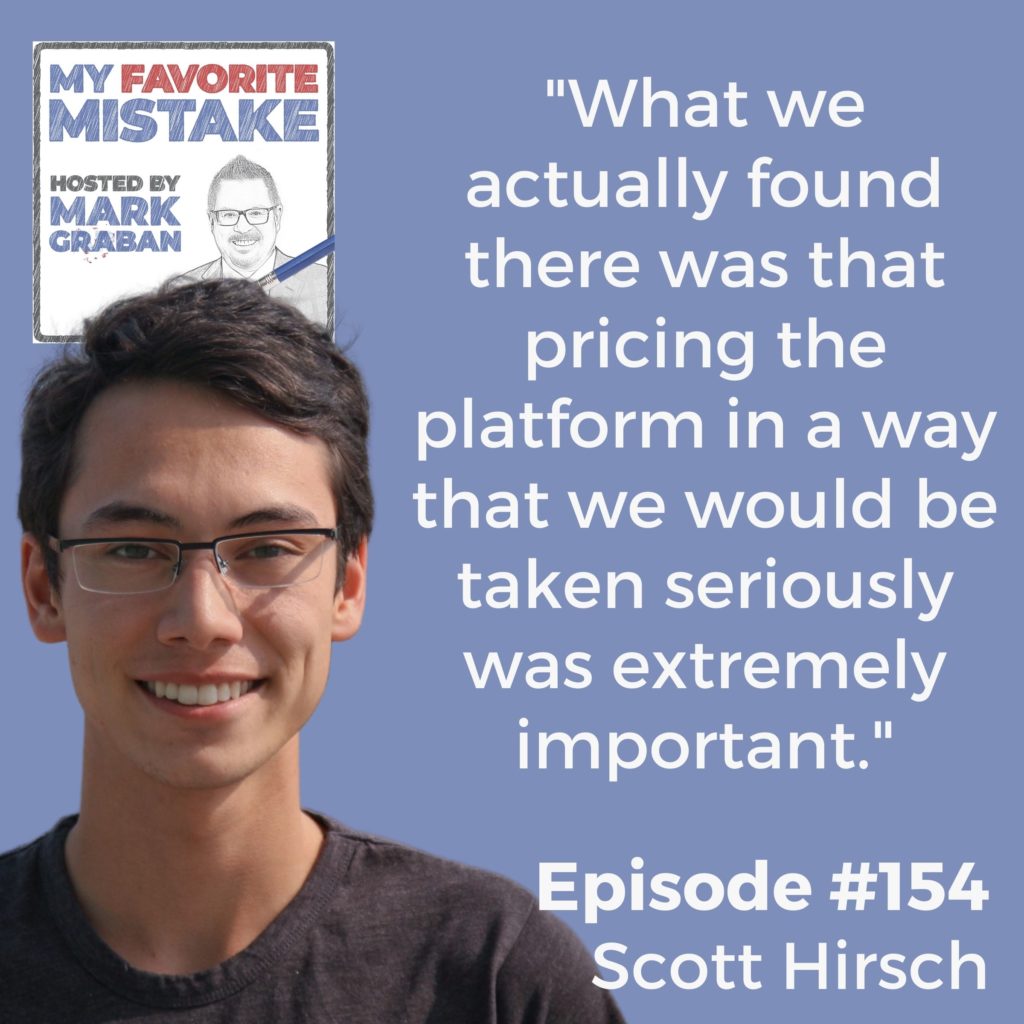
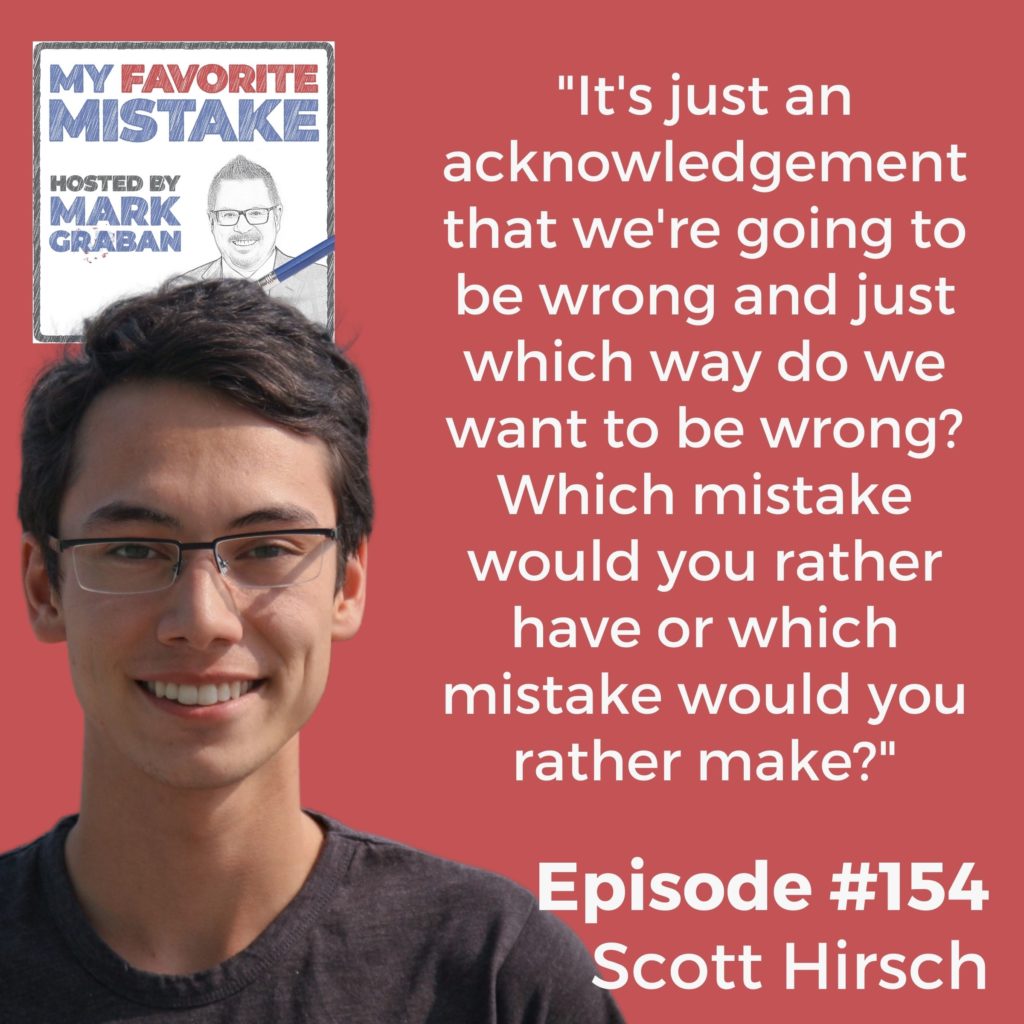
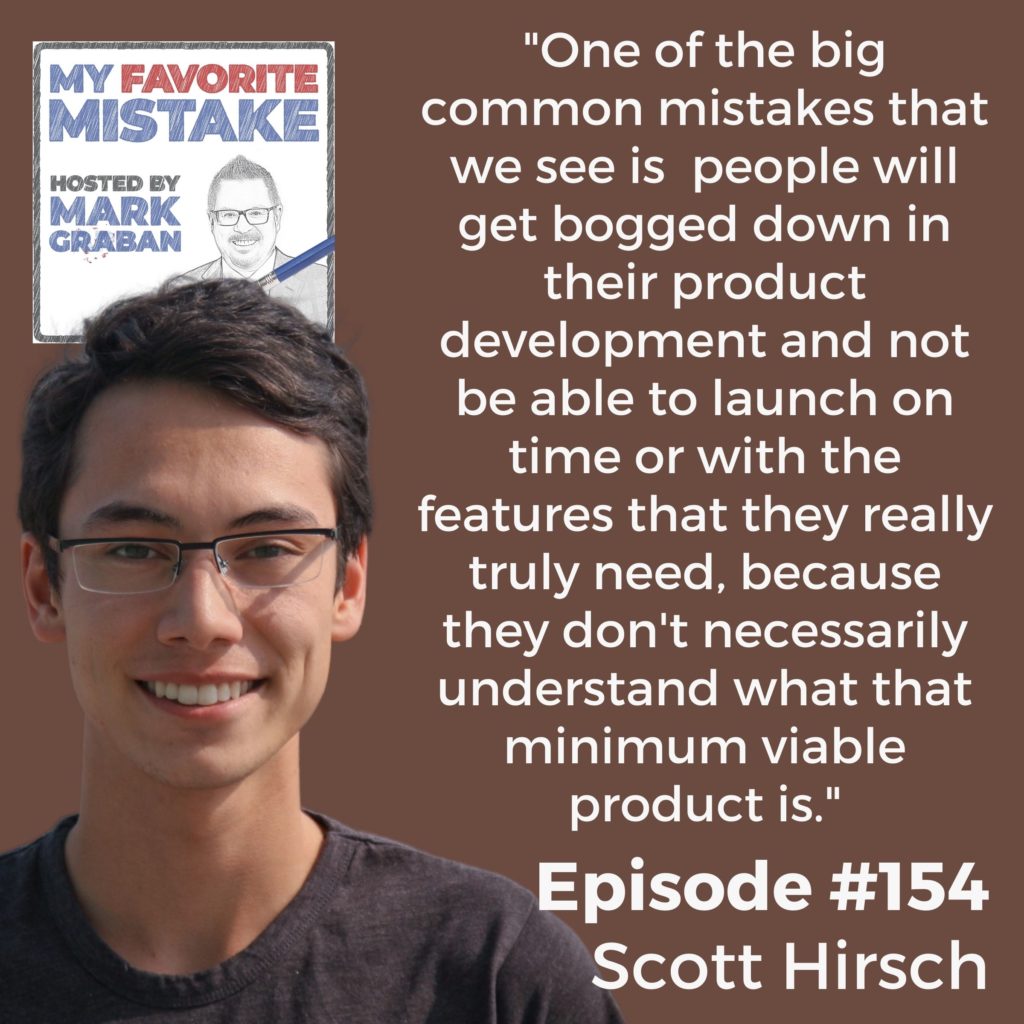
Subscribe, Follow, Support, Rate, and Review!
Please follow, rate, and review via Apple Podcasts or Podchaser or your favorite app — that helps others find this content and you'll be sure to get future episodes as they are released weekly. You can also become a financial supporter of the show through Anchor.fm.
You can now sign up to get new episodes via email, to make sure you don't miss an episode.
This podcast is part of the Lean Communicators network.

Other Ways to Subscribe or Follow — Apps & Email
CTO Scott Hirsch Learned That Free Wasn't The Best Price For His Software
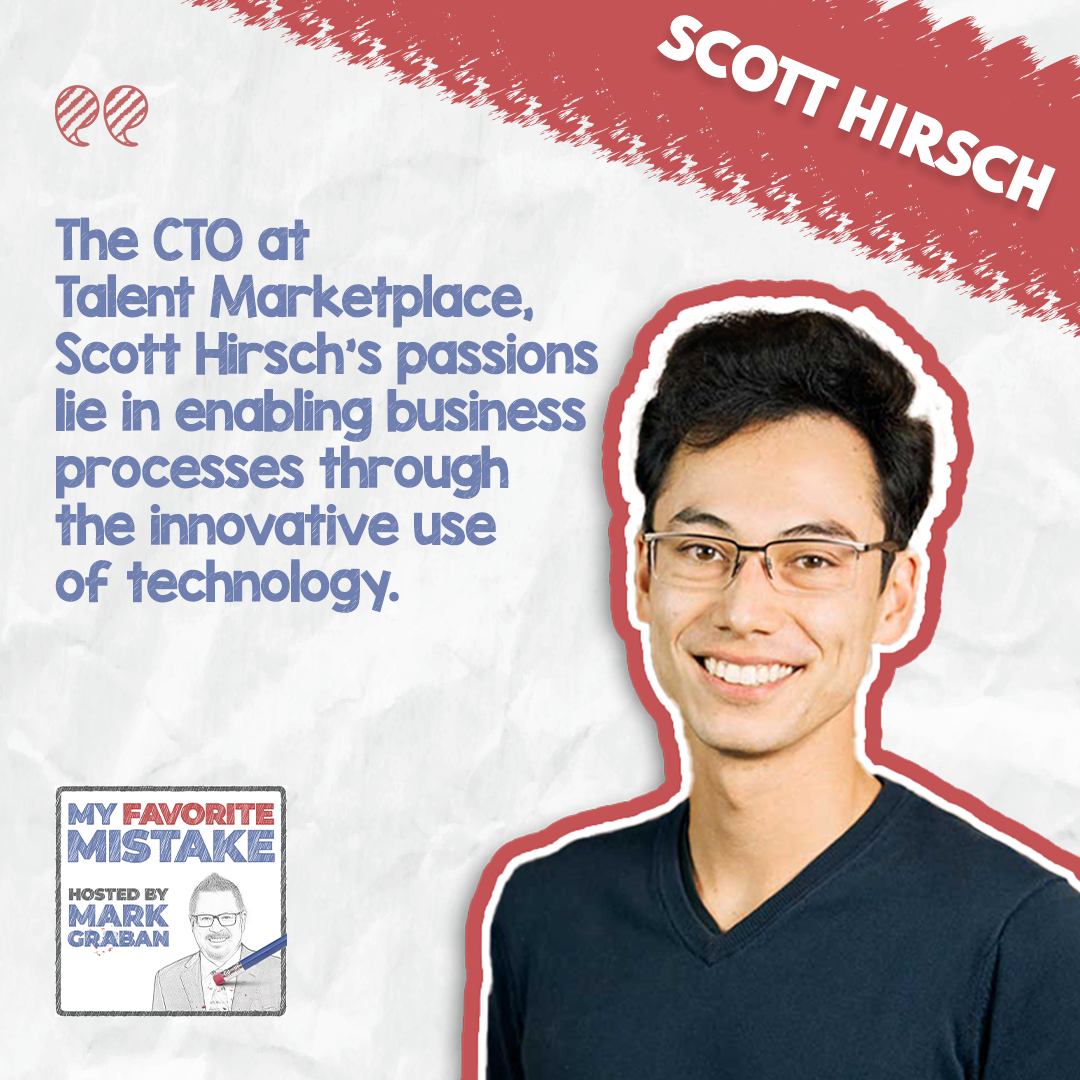
Our guest today is Scott Hirsch. He is the Cofounder and Chief Technology Officer at the HR platform, TalentMarketplace. With work experience combining business administration and computer science, Scott's passions lie in enabling business processes through the innovative use of technology. You can learn more about the company at TalentMarketplace.ca. That tells us you're joining us from Canada. Where are you connecting from, Scott?
Thanks so much for having me, Mark. I'm connecting from Vancouver, British Columbia on the beautiful West Coast here in Canada.
It is a beautiful place. It has been more than a decade since I've had an opportunity to be in Vancouver. I look forward to things getting a little bit back to normal and getting back up there sometime soon. I'm glad you could join us. There's a lot to talk about. Talent is a hot topic in many circles. We'll learn more about you and the company. As we always do here, we'll jump right in. What would you say is your favorite mistake?
My favorite mistake in a professional circumstance was probably early on in the TalentMarketplace life cycle here. We initially priced the TalentMarketplace platform for free when we launched our beta platform back in February 2017. What we found there was nobody signed up, even though we're offering this great platform, this great technology, some free talent, and access, all pre-screened right up for free.
We’re serving it on a silver platter for anyone that could enter their email address and set up a password. We thought it was a deal that was too good to be true. We thought we would have hundreds of thousands of people knocking on our doors to get onto the platform, but that wasn't the case. What we found there was pricing the platform in a way that we would be taken seriously was extremely important.
[bctt tweet=”Pricing the platform in a way that you will be taken seriously is extremely important.” via=”no”]
It's tough when anybody launches a new company or something web-based. A lot of times people think, “If we build it, they will come.” It’s the baseball movie Field of Dreams. You launched and you want that traffic to be there. Did you have data that showed people are finding the site, and then at one point, they're not registering or they're starting to register and not completing it, or registering and then not using it? I'm curious about what you did to try to help investigate what was the root of the problem.
There are a couple of things. I think you had the answers in some of your suggestions there as well. First of all, we had the wrong mentality to start with. We thought, “If we build it, they will come. How could they not want our wonderful platform? Everything that I build is amazing.” That's obviously not the case. We needed to do more market penetration, more advertising, more conversation, and more business development to get the word out about TalentMarketplace and our platform into the community to entice those people to come to the platform.
What we saw from the metrics and the analytics was that people weren't discovering us to start off with. A lot of candidates and people that were looking for work were able to find us all right, but we didn't do such a great job on the employer side and having employers sign up. That being said, we also saw some bounces from employers that started the registration process, and then basically stopped or didn't use the platform or something like that.
The way that we investigated that one a little bit further was we sat down with them and had that conversation. It was like, “You came to the site and you didn't sign up. Can ask why?” They're like, “It seems a little bit sketchy.” That probably wasn't the precise word that they used, but not legitimate or something along those lines. I think part of the reason for that was that pricing decision that we made early on to make it free. If we didn't take ourselves seriously and put a price tag on our platform, our efforts, and our candidates, then they were not going to take us seriously either.
How long did this take to sort through all of this and come to the realization that the pricing was a major concern, and then to start some experiments? What was the non-zero number that you all went with?
It took about two months of us trying to figure out what was going on and making some experiments. I remember the mindset very clearly too. It's like if we raised the price, it's just going to make things worse. Of course, we're free. How can you raise the price?
At some point, there's some basic supply and demand. A higher price would mean less demand, but there's more to it.
When we started to do the investigation and we started to have some of those conversations with the employers that weren't necessarily signing up right away, we started to discover the reason why. That's why in about two-months-time, we raised the price to a very trepid 10% of an annual salary or higher, which is quite low for the recruitment industry here.
That was also us tiptoeing in the right direction. We weren't ready necessarily to jump full force into putting our full price tag on right away. That was almost another mistake that we made because we ended up raising our prices again later that year, and then we have subsequently raised our prices once or twice since then as well. We're always willing to work with clients that are looking for the right pricing structure for their businesses too.
There was the mistake of free, and then the mistake of still not quite high enough to be legitimate or going from “I don't trust or like it because it's free” versus “I don't trust it because it's too cheap.” As time goes on, I imagine there are lessons about pricing being an art as opposed to being a precise science. I'm trying to remember back to MBA times and all kinds of dynamics come up.
Luxury goods where something seems like an outrageous price, but it's worth that because people are willing to pay it because it signals whatever brand equity that might be there. It's complicated. What's your advice for other entrepreneurs or other business owners to try to figure out the sweet spot of not leaving money on the table by underpricing or not overpricing to the point where you scare people off for that reason?
My piece of advice for new entrepreneurs or people looking to price their platform, their product, their time, or whatever it might be, would be to make sure you value yourself, your time, and whatever product that you've put together well. That means maybe not be free unless you're pursuing a freemium model or something along those lines. Put a price tag that is reasonable so you make a little bit of money, but it's also affordable for your potential customers. Also, be willing to be flexible.
One of the reasons that we were able to be successful eventually with our pricing models is that we continue to be flexible with our pricing. What that means is maybe $5,000 at once is too expensive for a person or a business. Maybe that's a monthly payment instead. Maybe it's a, “If you're able to sign in the next 30 days, I'll give you 10% off or 20% off to help make it a little bit easier.” Always keep those interesting mechanisms and levers in mind to be able to make it a little bit more palatable for your customers.

I was going to ask you about this idea of a freemium model. Can you talk a little bit more about that and more broadly how some companies use that strategy?
Usually for a freemium model, what that looks like is it's usually a platform or a software-based company that offers free sign-up and a limited set of features for free. Maybe it's a video recording platform that says you can use up to five videos on your site, and they can all be 25 minutes long. It could be Zoom, for example. You can have meetings up to a certain length of time or something like that. If you want to have unlimited meeting times and record your videos, then you have to pay a certain monthly subscription. That would be what a freemium model looks like.
You're right. Zoom is a good example of that. The one scheduling tool that I use for scheduling the calls, YouCanBook.Me, which is similar to Calendly, which is a little bit more popular. That's definitely a freemium model, but I was getting so much value out of the free version of it. I started feeling guilty because I thought, “I really like this tool. I want them to survive. I signed up for the paid tier because I could afford it and it was reasonable. It seemed like it was worth contributing to. It's not a donation because I was getting something of value in return. I'm not asking them to raise the price, but it goes to show that pricing is a tough thing to figure out.
One other thing I was going to ask back and I'm curious. Maybe in the course of answering this, you can tell us a little bit more about how the platform works. You've got people posting jobs. You've got people looking for jobs. It seems like early on when you launched something like this, there's a chicken and egg problem. How do you attract job posters without a lot of job seekers, and vice versa? How did you address that?
I'm going to broaden it a little bit and say that this is the classic marketplace teeter-totter conundrum that we'll never solve. It'll always be unbalanced, but we do our best to balance it. You're absolutely right. It is a chicken and egg problem. The way that you start is you either pick the chicken or the egg. You got to start with one. What ours was we started with the candidates because that was a little bit of the lower-hanging fruit for us in our market when we were starting out. We got about 20 or 30 of our friends. All my candidate profiles are very smart and hardworking professionals.
That was enough to go to 1 or 2 of the employers on the other side or let’s say the chicken side, and then bring those candidates or the eggs to them and say, “How about any of these?” They would sign up, and then that would bring on more candidates and employers. It starts to scale quickly, but the decision needs to be made early on. I'm going to start off with this group of people that I know or this market that I already have. I get them onto my marketplace platform, and then I'll grow the other side from there.
I'm curious to hear a little bit more about the founding of TalentMarketplace. Do you have a cofounder who is more focused on the business and marketing side of things where you're focused on the tech? That's a common pairing. What were your circumstances?
There are three of us at the university. We’re all friends. We went off and did our careers for a few years. One of our buddies called us up and was like, “I have this great idea. I'm seeing a challenge, particularly in the healthcare industry, for hiring contractors.” It started off as that. We think that there's a great opportunity to be able to automate a lot of this process, build a platform to help facilitate these hires and save them a lot of money.
It took about a year in 2015, doing it part-time on the side of our desks outside of our regular jobs, to build out an initial MVP at the platform, get some candidates onto it, and get some employers onto it. We explore a little bit more about whether or not there's some viability for this. After about a year of testing it, we thought that there was something there. We all ended up quitting our jobs in December of 2016 and took a run on it full-time.
From there, we had a couple of months where we made a pricing mistake early on, but then we quickly pivoted. We managed to get a little bit of revenue into the business and break even in terms of covering our costs for the platform build early on within that first year. Since then, we've been able to scale the business pretty well.
You're absolutely right, I cover most of the technology stuff. One of my other partners covers all of the recruitment in terms of helping encourage candidates to come on the platform. As well as account management and getting those candidates in front of employers. We have a bit of a sales and marketing sharing that's going on between the two of us as well.
You talked about that pricing mistake that you admitted, but it sounds like you did a lot of things well. You avoided some mistakes that people would sometimes make. For example, the mistake of quitting a job too soon before the side gig is validated. Making the mistake of assuming something will work instead of testing the different aspects of it that you mentioned before launch. I know some of the terminologies you used like MVP and pivot from Lean Startup Circles. For those in the audience who don't know about some of those models, can you share in particular what MVP stands for and what that meant for TalentMarketplace?
It's not Most Valuable Player in this instance, but in business circles or the lean startup world, it's Minimum Viable Product. The reason that that's so important is because you want to have and understand the most minimum base set of features that are essential for getting your customer to buy. In the technology world, we particularly love to have every bell and whistle feature, “It would be great if you could change 10 different colors, support 5 different languages, and have this feature and that feature.”
Those aren't necessarily the core value of the product, and they might end up delaying your launch or being over-complicated. What you need to get out as fast as possible is that minimum viable product that delivers the most value to your core customer as quickly as possible. That's one of the big common mistakes that we see. People will get bogged down in their product development and not be able to launch on time or with the features that they truly need because they don't necessarily understand what that minimum viable product is.
[bctt tweet=”People get bogged down in their product development and are not able to launch on time or with the features that they truly need because they don’t necessarily understand what that minimum viable product is.” via=”no”]
Our guest is Scott Hirsch. He's the CTO at TalentMarketplace. We're learning not only from the mistake they made, but we're also learning from mistakes that could have been made and mistakes that other people make. In startups, there's so much risk involved in taking those steps to move forward. Testing and validating ideas is so important. You may have stated it differently, making small mistakes early on so that we can prevent a bigger catastrophic mistake down the road. I'm glad to hear that you figured out the pricing thing, you survived, and you've grown and scaled. That's always so good to hear. There’s one other thing I wanted to come back to. You talked about the mindset that you've tried to create within TalentMarketplace about mistakes. Tell us more about that.
It's just an acknowledgment that we're going to be wrong. Which way do we want to be wrong? Which mistake would you rather have or which mistake would you rather make? It's the mindset that we try to foster at TalentMarketplace. We're not running around trying to screw everything up but it's like, “Is the pricing going to be 10% or 15%?” They're both probably wrong, but one might be a little bit more wrong. Which way would we prefer to be wrong?
[bctt tweet=”It was just an acknowledgement that we’re going to be wrong, and just which way do we want to be wrong? Which mistake would you rather have, or which mistake would you rather make?” via=”no”]
We say, “Let's pick the 15%.” That's still probably wrong but at least we can move down a little bit if they ask us. Whereas going from 10% to 15% or 10% and pushing it up might be a little bit more difficult. It's that acknowledgment that whichever way we're going to pick our poison, we're probably going to still suffer a little bit. It’s acknowledging that we might make them at stake again and we will pivot to make it better.
Does the same idea apply when it comes to technology decisions that you're addressing, leading, or working on?
Absolutely. That's that whole A/B testing that we do on the site quite a bit. First of all, we do our best in order to track the metrics of usage on a site. Is this button being used? Is this feature being used? How can we make it easier for the candidates and employers on the site? We have some ways to track that, and we use that information to make some of the decisions we choose to make around the feature implementation that we do.
We make mistakes there too. Sometimes we roll up features that we think, “Everyone said they want this thing.” I'll give you a specific example. Candidates will often request on platforms like this for the profile to be anonymized or hidden from certain companies. Maybe they don't want their current employer to see that they're searching for work. It's a very common situation to be in. I totally empathize with that.
On the very first iteration of TalentMarketplace, we had an anonymizing profile feature. It'll change your first name and last name to just the initials. It'll remove your profile picture and put something default there instead. Just to make it a little bit more anonymized for them if you want to hide from certain companies, for example. After two years, nobody used it, even though it was heavily requested. That was one of those interesting mistakes. I don't want to say it's a mistake to listen to your users. That's definitely not the right message there. It's something that's asked for versus something that's needed, I suppose.
That's something that happens a lot. I had a little bit of exposure to software companies. It’s that exact same situation where many people will say, “We want to do this with the software.” When it's built, you're trying to scratch your head and figure out, “It's there. Why not use it?” It could be a chicken and egg dynamic.
I think of another initiative. It wasn't a software company per se but in some healthcare circles. I was part of a group that was trying to help organizations both in Canada and the US learn from each other. One of the things we heard a lot of feedback from different people was, “We want a platform where we can share improvements we've made in our organization so that others can pull and draw from those.” It was a different chicken and egg problem. It’s not a job seeker or job poster. I think what people were saying was, “I want a repository that I can go and pull from. I want to see other people's ideas. You go first.” Fingers are pointing in different directions.
The technological capability was there, but then there was more of that social challenge of how do you get someone to contribute to the common good there before pulling on it. There's no ill intent from anybody. I think it just goes to show that if we'd agree pricing is complicated, people are complicated too. Something sounds good, and then when push comes to shove, they don't follow through with it. Have you learned some methods to try to better validate or do small tests? Can you do a minimum viable feature in a way to see? People say they're going to do it but before we build out the fully formed version of it, let's test and see if people will click and take action.
We do very much that. We roll out a small feature and run an experiment with it. The mentality that we try to take is we do it manually first. It’s like mechanical torque the feature to start off with to see if people will use it. If they do, great. We're doing it manually. As soon as that manual process doesn't scale anymore, then we say, “Let's automate it. We're going to build this into the platform.” That's how we run that experiment for that piece.

Those are good lessons that apply especially in software settings where you can iterate so quickly. There are probably applications to other service industries where you could try to test some less automated version of a process, and then go and put more effort in once it has been validated the best you can. One other thing I was curious about. Imagine this is a pretty competitive marketplace for TalentMarketplace. I want to talk for a minute about the competition for employees. There are a lot of job boards that have existed at this point for a couple of decades. I'm curious to hear even as it goes to your origin story of entering a market where there are already existing players. What gives you the courage to go into that and try to differentiate yourselves?
I think the important piece there is the market research that was done upfront before entering into this business and this industry. Basically, we took a look at the recruitment industry as a whole, in Canada, across the US, and in Europe. We saw that it was growing about 8% to 9% year over year, COVID aside. The actual rebound from post-COVID has been interesting. Maybe that's something we could talk about too.
The market research for the recruitment industry as a whole was showing that it was a growing industry, which is cool to see. In addition to that, we looked at the barriers to entry for the recruitment industry as well. Yes, it's highly competitive. There are a couple of big incumbents in the market, but then there are also hundreds and thousands of little guys. The barriers to entry into the recruitment industry as a whole are pretty light.
There's also a bit of stagnation in terms of the combination between technology and HR. HR seems to be a little bit behind for some reason in terms of the adoption of technology. It's very manual heavy and I think that has to do a lot with the people and relationships that are involved there. I think there still is a lot of space for technology and automated solutions to help build those relationships even stronger. People are very important in this industry of course, but I think that there's a lot of space for technology to grow into that. That's the analysis that we did to enter the market.
Here we are at the beginning of 2022. It seems like in a lot of cases, it's the job seeker's marketplace right now. There are shortages of employees, especially in certain fields for all sorts of different reasons like demographics, COVID, and what have you. When you think of what your customers are facing, what they're trying to address, and what you're hearing from them, how would you describe some of the biggest hiring challenges for companies trying to compete for talent?
You're bang on there, Mark. One of the biggest challenges that employers are facing right now in hiring great talent, specifically for IT, technology development, and hard-skilled-based talent, is there aren't enough of them. It's as simple as that because everyone is like, “I want a senior developer with five years of experience in React.” React was invented in 2013. It has only been relevant for about four years, so if you're looking for someone with five years of experience in that, it's utterly impossible.
Some of the skills don't exist quite yet. The institutions, the universities, and the coding boot camps are trying to keep up and turn out more people that are looking to transition into industries such as technology. They're doing a great job at it. I think that a lot of government support exists too. I know up here in Canada, there are a bunch of grants to help whether it's the youth or new immigrants or people transitioning careers from the oil fields into technology for example. Those grant programs exist to help support people to get into that market too.
The main challenge that employers are facing is there are not enough of those types of folks that are available. Particularly smaller companies can't compete with the Amazons, the Microsofts, and the Googles of the world because they don't have brand recognition. They may not be able to offer all of the perks as the ping pong tables, the remote work, and all the other benefits that might come with working for a big-named company like that. They just don't get the applicants that they're looking for at the smaller companies. It's an all-around storm of different challenges that particularly small employers are facing like brand recognition, being challenged to compete with salary and compensation, and competing for a very limited amount of talent that exists in the market currently.

It sounds like there are a couple of different categories of challenges or causes of that hiring challenge. Some of which are market dynamics. One example you've used, and I've heard this from some other technical people I know, is the mistake or the unforced error of requiring five years of experience with this tool that has only been in use for four years.
Are there times at TalentMarketplace when you try to flag issues like that? Does that require a manual review? What are some ways that you can try to help a company with a job identify some of the issues that might be preventing applicants from applying or taking it seriously, or having some sort of filter that filters out everybody inadvertently?
That's one of the reasons that TalentMarketplace is different too. We completely pre-screen and vet both sides of the marketplace before they're able to come on. It's different from LinkedIn or Indeed where anybody can post a job, anyone can put their resume up, and anyone can apply. We make sure that 100% of the candidates have a resume review and phone screening, and that they are who they say they are.
It's the same with the employer side too. When an employer posts a job or requests a role that says, “I need somebody with five years of experience in React,” even though it might not be possible. It's incumbent on us, TalentMarketplace, to make sure that the employer understands the reason that it might be challenging and the reason that they might not be getting as many candidates for that role specifically. That's why we have a bit of a differentiator at TalentMarketplace too because we are pre-screening and helping genuinely both sides define that perfect match.
That's interesting having some of that pre-screening in place. I've seen these stories, you may have seen these too, where you have people working remotely in technical jobs who are in some cases now, taking 2 or sometimes 3 full-time positions. Have you seen some of these stories?
I've heard about this. Sometimes they'll outsource one of them to another country or something.
People are realizing, “This job doesn't require 40 hours a week,” if that's the threshold or as you said, they're playing this maybe unethical arbitrage game with collecting the paycheck, and then farming it out. They might say, “Companies do that. Why not employers?” There are all kinds of dynamics there. Does the screening help ensure if one of the employers came to you and said, “Scott, I want to make sure I'm hiring somebody who is only going to have this as their job?” Is that overblown because there are a couple of stories that got a lot of press?
I think it's the latter option there. I think they're a little bit overblown because they get a lot of press. It's particularly relevant and relatable for a lot of folks right now, shifting to the work-from-home culture. That being said, it's not impossible for that to happen. That's part of the reason why, shameless plug for TalentMarketplace, pre-screening is valuable. If you're just going to pull a resume off Indeed or something like that and they say, “I can work and I can start remotely,” great. I think that'll work in probably 99% of cases, but there might be that 1% or 2% that presents one of those challenges.
Don't apologize for plugging the company. That's fine. I don't consider that a mistake. I'll plug the company again. TalentMarketplace.ca is the website. We have a lot of audiences here in the US. Do you serve job seekers and employers in the US or Canada only?
For the time being, we're mostly focused on Canada, but expanding into the States is definitely on our radar. We're hoping to get down there, hopefully. We'll probably start up by pursuing one of the employers down there, and then build the talent pool around that because we're still figuring out geographies. It will most likely be West Coast Seattle as a starting point because it's very close to Vancouver, but then we might expand down to the West Coast California, or maybe into Colorado as well. We'll see where we end up.
It sounds like there’s an opportunity there to build upon lessons learned from earlier growth and earlier scaling.
Also, make new mistakes.
New mistakes, new learning.
Yes, exactly.
I'm curious to hear your thoughts on the impact of the pandemic, in particular, accelerating work from home. I'm guessing in a platform like yours, you have a lot of data that would help illustrate those. Do you have more people accepting jobs in other provinces and other area codes? I bet you could see some of that pretty vividly through the data.
Yes. That's one of the most interesting things about being in a technology-focused recruitment platform place. I remember the beginning of the pandemic. Everything came to the beginning of the pandemic, and that's just the way it was. Coming out of the recovery here, we've seen a lot more power in the hands of the talent and the candidates that are looking for work. Particularly around straight-up demanding work from home as an option. I think about 85% or 86% of the candidates on our platform right now will not consider a job if it doesn't offer at least a hybrid like working from home. That's such a big shift even a year ago or two years ago. It's so interesting that people have reprioritized their lives on that. That's one piece of data that's very interesting.

The other one that stands out to me from a COVID perspective is that employers are looking abroad for their workforce now. Because they're offering remote, they can say, “If I pay somebody $200,000 a year from the Bay area, why not pay somebody $100,000, perhaps equally skilled from Kansas.” Something like that. They're looking farther abroad in different ZIP codes for their talent.
There are a couple of sides to that coin. One is trying to hire people at a lower price based on where they are. Also, you see articles of somebody moving from the Bay area to someplace with a far lower cost of living, then there's this question of, “If I bring this much value to the company, why would you want me to take lower pay because I live somewhere else?”
It's a tough dynamic, but I think in a job market where the employees have much more leverage, you've got to do what you can to maximize your earnings in a job you like. I'd be curious if there are similar data in Canada. In the US, we've had at least five months in a row now of all-time record numbers of people quitting their jobs. Is it the same thing in Canada?
I would say so for sure. This is anecdotal. I don't have data to support this, but I think that's a reevaluation of a lot of people taking a look at their lives and saying, “I've been working from home for a while. It has been great to be able to spend more time with the family and the dog. I want to make that shift in my career, pursue what I love, or make that decision to make it a little bit easier.” It's interesting to see for sure.
There's a final thought adaptation from the story you told. Our guest has been Scott Hirsch. He's a Cofounder and CTO at TalentMarketplace. Their website is TalentMarketplace.ca. You were talking about underpricing yourself and not valuing your offering in the marketplace enough. There's a lesson there for individuals who are tuning in. Please don't undervalue yourself and what you are worth in your job and the industry you’re in.
If you're looking for something new and you're in Canada, maybe shortly in the future here in the US, TalentMarketplace can help. Scott, I thank you for sharing your story and reflections. I always appreciate it when someone is willing to come on and share a mistake. I'm glad it's one that you learned from and got past it. Thank you again for being here with us.
Thank you so much, Mark. It was a lot of fun.
Thanks again to Scott for being a great guest. To learn more about him and TalentMarketplace, you can go online, MarkGraban.com/Mistake154. As always, I want to thank you for tuning in. I hope this show inspires you to reflect on your own mistakes, and how you can learn from them, or turn them into a positive. I've had people tell me they started being more open and honest about mistakes in their work. They're trying to create a workplace culture where it's safe to speak up about problems because that leads to more improvement and better business results. If you have feedback or a story to share, you can email me at MyFavoriteMistakePodcast@gmail.com. Our website is MyFavoriteMistakePodcast.com.
Important Links
- TalentMarketplace
- YouCanBook.Me
- LinkedIn – Scott Hirsch
- Twitter – Scott Hirsch
- YouTube – Scott Hirsch
- Facebook – Scott Hirsch
- Instagram – Scott Hirsch

